Magnolia liliiflora is renowned for its lily-like blossoms that display themselves proudly standing upright on their branches. You’ll often notice Magnolia first by their littered ‘petals’ blanketing the ground below which look so beautiful you don’t want to walk on them.
Magnolia liliiflora goes by many common names such as the Mulan Magnolia, Lily Magnolia and Tulip Magnolia referring to its tulip-like, erect flowers.
More...
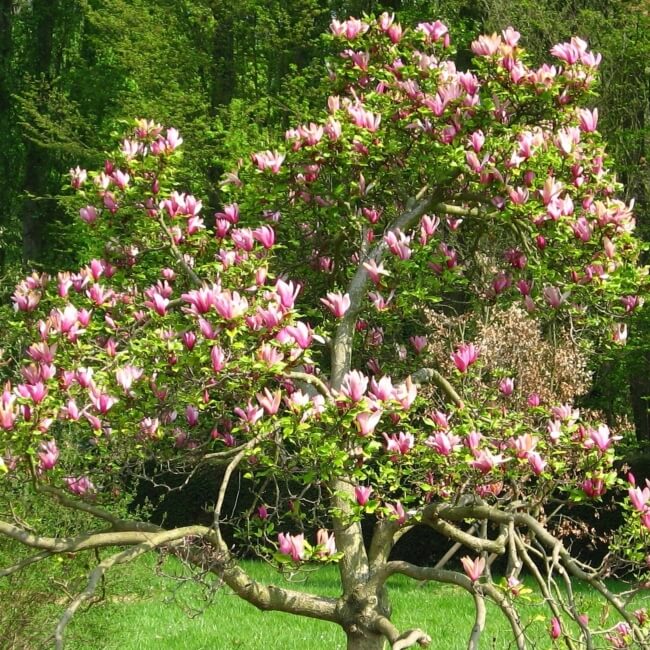
Source: Gardeners Dream
Family: | Magnoliaceae |
|---|---|
Genus: | |
Species: | M. liliiflora |
Common names: | Mulan magnolia, Lily magnolia, Purple magnolia, Red magnolia, Tulip magnolia, Woody orchid, Japanese magnolia |
Origin: | China |
Location: | Outdoor |
Type: | Small trees or shrubs |
Growth: | 4m tall - 4m spread |
Sun requirements: | Semi shade |
Foliage colour: | Green |
Flower colour: | Pink or white |
Flowering: | Winter to spring |
Edible parts: | Flowers |
Maintenance level: | Low |
Poisonous for pets: | No |
What is Magnolia liliiflora?
Being one of the smallest magnolias, Magnolia liliiflora will eventually reach a diminutive height and spread of 3m, but its slow growth and compact size make it a perfect investment for petite gardens or container specimens.
Mulan Magnolia will reward you with truly stunning flowers, light pink to mauve on the outside and white on the inside, that appear before the leaves in spring. The slender blossoms open and spread out as they age.
The Magnoliacea family is considered to be one of the earliest surviving flowering plant families. Its flowers evolved before bees so have adapted to be pollinated by beetles and other pollinating insects predating bees.
Once pollinated, magnolia will produce fruit that are not considered to be edible and can often contain toxins. This multi-stemmed ornamental magnolia was traditionally grown in the gardens surrounding Chinese and Japanese temples.
Magnolia liliiflora has been cultivated for centuries and is the parent of many successful hybrids due to its appealing characteristics.
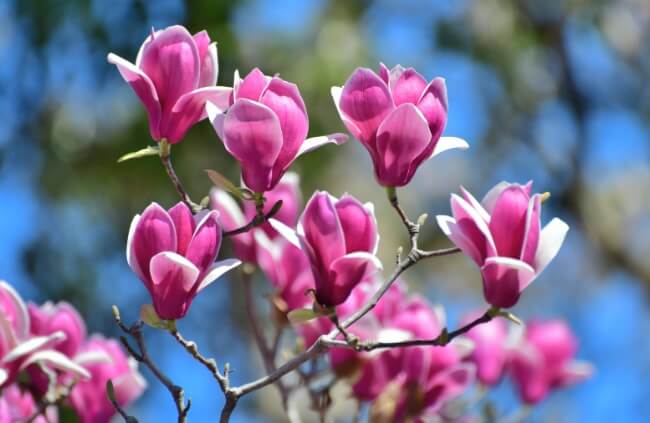
Mulan Magnolia Plant Features
Mulan Magnolia’s beautiful blossoms begin life as velvety buds, brownish green in colour. They have that iconic fuzz that all magnolias have which protects their delicate flowers from the harsh frosts and sharp winds of winter.
The sugars and sap within this fur coat will also act as an antifreeze. This amazing adaptation is incredibly soft to the touch but is, in fact, a strong and protective case underneath to keep the Magnolia ‘petals’ undamaged.
The flowers of the Lily Magnolia consist of tepals which is the classification of neither petal nor sepal. Normally in groups of 6-7, Mulan Magnolia's tepals are wider than that of Star Magnolia, and ovate in shape, forming a goblet.
The most common cultivar of Magnolia liliiflora is ‘Nigra’ as it’s applied to a few cultivars in a similar colour range. Rich dark red to purple flowers are what sets this variety apart from its relatives.
Mulan Magnolia’s Natural Habitat
Magnolia liliiflora is native to China, specifically Sichuan and Yunnan where they represent purity and nobility and were chosen for temple planting. The first Mulan Magnolias that arrived in English-speaking countries were often cultivated in Japan. This association led to many places incorrectly referring to the Lily Magnolia as the Japanese Magnolia.
Magnolia grows naturally in forests and mountain slopes at high elevations, but always in and around moisture-retentive areas. However, any wild distribution of Magnolia liliiflora has since been obscured by heavy cultivation.
Magnolia is one of the earliest known plants in evolutionary history, with fossil records showing their distribution in Asia, North America and Europe over 100 million years ago. Originally found growing across the globe, today the Magnoliacea family are indigenous only to Asia but are also found growing in the southeast United States.
Benefits and Uses of Magnolia liliiflora
Magnolia flowers have been consumed for millions of years throughout different cultures.
Most often used in pickling, the tepals of the magnolia flower are edible but can also be eaten when young and tossed through salads. Magnolia tepals can be eaten as a tangy condiment when preserved in vinegar. This, unfortunately, doesn’t preserve the beautiful colours.
They can also be added to rice for flavour in Asian dishes and gently infused teas. They are often described as having a gingery flavour with hints of clove, and Magnolia liliiflora in particular having a slight taste of cardamom.
Overall, each Magnolia cultivar can have slightly different flavour profiles, but some are more suited to pickling or infusing rather than eating. Along with their edible uses, magnolia is known to have medicinal uses too.
The bark of magnolia trees is found to be useful in treating tremors caused by Parkinson’s disease, but most medicinal benefits seem to come from their flowers. Young magnolia flower buds are used as an analgesic, said to relieve headaches.
Often the tepals are used to treat common colds including many other ailments that claim to have seen an improvement after using magnolia medicinally.
How to Grow Magnolia liliiflora
Magnolia isn’t usually considered to be difficult to grow in a domestic garden. However, there are some conditions that all magnolias prefer. By considering these conditions, choosing and planting a magnolia variety should become a much clearer endeavour.
But first, it is essential to purchase your magnolia from a sustainable supplier as populations of magnolias, in general, have dramatically depleted due to poaching and urbanised development.
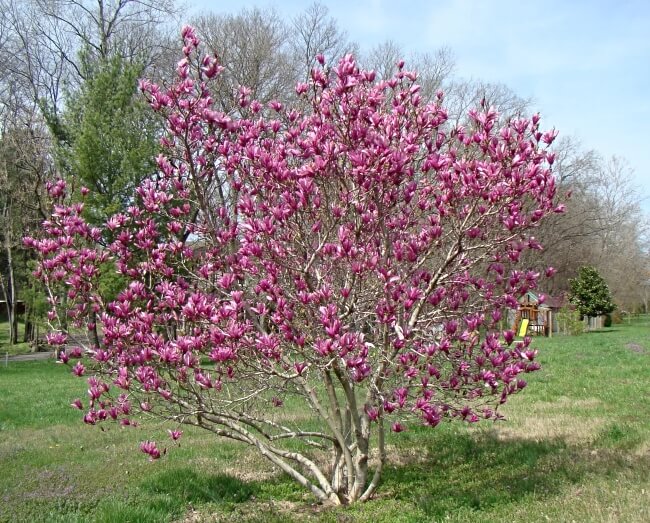
Source: New Blooms Nursery
Ideal Position for Growing Mulan Magnolia
Soil & Drainage
Plant your magnolia in moisture-retentive, humus-rich soil with good drainage. Use ericaceous, acidic compost for the best results. They will also grow in neutral to slightly alkaline soil, but may not flower as profusely.
Despite the general advice for soil types, magnolia is well adapted to most soil types, and can tolerate heavy clay or very dry sandy substrate, and mature plants are also fairly drought tolerant.
But like everything in the garden, aiming for their ideal conditions will help to promote healthier, lusher, more floriferous growth.
Light & Temperature
All types of Magnolia will thrive in a temperate climate, given enough light and warmth to develop, but they also need shade to keep that balance right. Depending on the climate you live in, you may need to protect your magnolia from the harshest of midday sun.
Observe the sun as it travels over your garden and plant your magnolia with this in mind. In addition to this, you can also temporarily shelter your magnolia with an awning or screening structure against potential scalding of flower buds.
Magnolia liliiflora is tolerant of low temperatures, but prolonged frost can cause damage to buds and flowers. Cover with a protective fleece. Or, if growing in a container, move to a protected area for the coldest periods. Cold will not affect growth or overall health, just flowering.
Shelter
Alongside general protection from harsh midday sun and severe frosts, magnolia tends to be susceptible to wind damage. Observe your space and take note of which way the wind travels.
Positioning your magnolia away from any strong gales, perhaps with a wind break or amongst other planting will help to keep your shrub flowering to its fullest.
Planting Magnolia liliiflora
Given their preference for acidic soil, consider grouping your magnolia with other ericaceous flora, providing shelter as well as beneficial growing conditions for the group. If space is limited, container planting works well with magnolias and means you can provide the ultimate conditions it needs in a portable way.
How to Propagate Magnolia liliiflora
All Magnolia have several ways of successful propagation and Magnolia liliiflora is no different. However, some methods of propagation are quicker and more successful in increasing your stock of this cherished shrub.
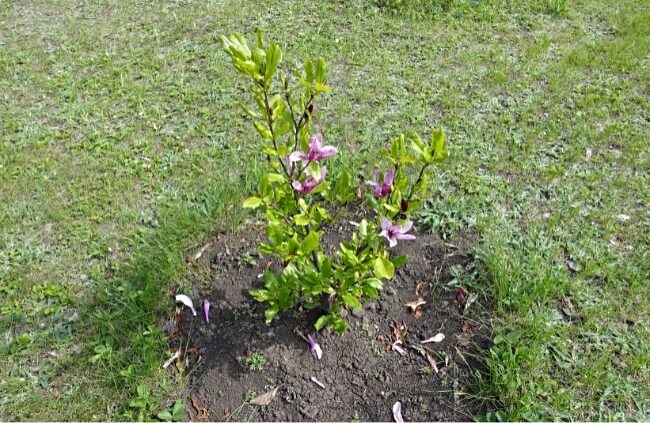
Propagating Magnolia liliiflora from Seeds
Growing Magnolia liliiflora from seed is possible but isn’t a quick endeavour, plants can take up to 10 years to flower when grown this way. Specific seeds can also be hard to find commercially and collecting from identified shrubs or trees may need a certain licence or permission from the landowner.
In addition, it is also prudent to know that the seed may not always come true. Given all of this, if you’re determined to grow from seed, Magnolia liliiflora fruit can be identified by the long, bumpy, peach-coloured seed pod.
Fruit is best left on the plant for stratification which will enable germination. Red kidney-shaped seeds will then enlarge. Sow seed sparsely in peat-free acidic compost and cover lightly. Grow on under protection, keeping well watered.
Propagating Lily Magnolia from Cuttings
Growing Magnolia liliiflora by cuttings is a quicker and much more successful way of increasing plant stock. Cuttings are to be taken in spring when new growth starts to appear.
Prepare cuttings by using sharp secateurs and taking either softwood new growth or semi-ripe hardwood including at least two nodes. Cuttings should be used immediately or kept in a sealed plastic bag with moisture and used as soon as possible.
Using a sharp knife, scar or wound the surface of a node to activate the plant's ability to create new roots. Remove any excess leaves leaving the top set in place.
You can also dip the cutting in rooting hormone if you have any in hand. Push the cuttings into some peat-free compost with added drainage. Then water well and cover to keep humidity in.
Caring for Purple Magnolia
All magnolias are low-maintenance additions to your space, making them commonplace for domestic gardens throughout the world. To keep them in the best possible health there are a few considerations to look at when caring for your Lily Magnolia.
When planting, it is essential to use ericaceous compost with an acidic pH between 5-6. Given that they will tolerate all soil, going that bit further for your shrub will ensure success. Once planted, give it a good drink.
During the first year of planting your magnolia will be creating fine feeding roots so it is essential to keep it well watered, especially if you live in a dry climate. You can aid the retention of moisture by using an acidic mulch such as ericaceous compost or bark chippings around the base of the shrub.
Pruning Mulan Magnolia
Pruning should be done after flowering so you’re not damaging any immature buds, but general pruning of dead, diseased or damaged branches can be done throughout the year.
Lily Magnolia is a fairly compact, multi-stemmed specimen and should provide an open bushy shrub, but if you find it has an area that needs encouragement you can tip prune.
Using the tip pruning method allows the branches to bush out without taking too much material away from your Magnolia. Using sharp secateurs, snip the tip of the selected branch to encourage side shoots.
Repotting Magnolia liliiflora
Growing Magnolia liliiflora in a container allows you to control the moisture, compost, light and space it needs. Lily Magnolia is a particularly perfect example of a magnolia fit for container growing.
Although fairly compact, Magnolia liliiflora will still need an adequate growing space as it matures so repotting will be essential. Their shallow roots mean that they don’t need an excessive container, but it is important that as it grows, it is given extra room for root development and it will, in turn, reward you with abundant blossoms.
Generally, if you haven’t repotted your magnolia in some time it’s a good sign that it will need to be repotted. Taking into account the girth of the trunk, allow for an extra 30cm of pot in width and depth per 1cm of the trunk. It may not be an exact science but will allow you to evaluate when it needs extra growing room.
Re-pot using peat-free ericaceous compost, filling in around the edges and keeping any grafting point above the surface of the soil. Adding mulch to the surface will also allow for extra nutrients to work their way down into the bulk of the root.
Common Magnolia liliiflora Problems
Magnolia liliiflora Pests
Magnolias in general don’t tend to be bothered by many specific garden pests, but they can fall victim to attacks from the usual suspects like caterpillars, beetles, grasshoppers, slugs and snails. Any superficial damage shouldn’t be detrimental to your plant's overall health, but it can leave wounds where infection can enter.
Pests can be tackled with tons of chemicals but, essentially, you’re not treating the imbalance in your ecosystem.
There will always be something to naturally predate what is afflicting your magnolia. Try to encourage beneficial insects to help treat it organically. Failing this, a good, strong burst of water will dislodge them from the plant.
Magnolia liliiflora Diseases
Occasionally, Magnolia liliiflora may have yellowing leaves, this could be a sign of improper soil condition. If you suspect your plant is suffering, try adding a thick ericaceous mulch, or if young enough, lift and move to a new location with acidic compost. Yellow leaves can also be a sign of heat stress, lack of water or sunburn, all of which can lead to defoliation if not checked.
Leaf spots of your magnolia could either be fungal or bacterial. Be vigilant for black, brown or reddish patches occurring on your magnolia leaves, some may have a yellow halo around or may be generally lighter in colour.
These problems are always exacerbated by wet and humid conditions surrounding your plants as fungal and bacterial problems pass through plant debris, water, close contact with lack of ventilation and even through insects. Given the right conditions, plants should recover but it can be more harmful for younger plants.
Leaf blight is identified by more centralised patches, larger and closer to the tip of the leaf. It can also be referred to as ‘tip dieback’. The treatment and prevention are much the same as bacterial and fungal spots, as it’s also a fungal infection. Harshly pruning and cleaning secateurs in between cuts will help contain and prevent further spread.
Verticillium wilt can be fatal for young and mature plants. Characterised by widespread leaf browning, magnolias will also have browned inner trunks when pruned. Plants will unfortunately not recover but progression can be slowed with proper precautions.
Magnolia liliiflora Frequently Asked Questions
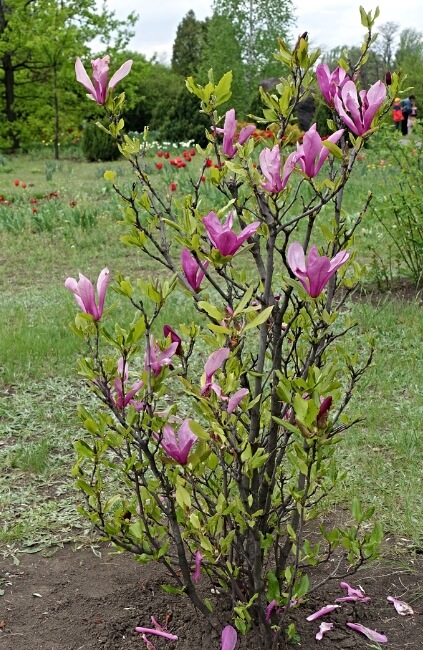
Is Magnolia liliiflora an evergreen?
Magnolia liliiflora is a deciduous tree or shrub, depending on pruning. It will lose its leaves in winter, but the resulting foliage in spring is much fresher and more impactful than seasonally inactive magnolias.
What is the common name for Magnolia liliiflora?
Magnolia liliiflora has many common names, the most famous of which is the Lily Magnolia, though we know it best as the Tulip Magnolia. It is also often referred to as the Red Magnolia, Purple Magnolia, and even the Woody-Orchid.
What is the use of Magnolia liliiflora?
Magnolia liliiflora leaves are used as a sedative supplement, with analgesic effects. The petals and unopened buds constrict blood vessels and help to restrict runny noses.
How do you identify Magnolia liliiflora?
Magnolia liliiflora is early to identify, thanks to its large goblet-shaped flowers with a more upright and narrow form than most. Different subspecies and cultivars have various and wide-ranging characteristics.
Is Magnolia liliiflora hardy?
Magnolia liliiflora is a hardy plant, resistant to frosts down to about -6°C. They are more damaged by wet winters than cold winters.
Is Magnolia liliiflora suitable for small gardens?
Magnolia liliiflora is perfect for small gardens, with a restricted growth habit and tidy form. It is easy to care for but will add controllable height and seasonal interest in otherwise limited space.
Showcase Exquisite Blooms in Your Garden with Magnolia liliiflora
There’s nothing quite like the uplifting beauty of a magnolia in flower in spring, providing that catalyst for seasonal growth and future gardening ventures. Mulan Magnolia’s ornamental qualities give that intense hit of colour when it’s most needed and pull us quickly out of winter.
Plant a Magnolia liliiflora for the unsung heroes of the pollination world; beetles. They are also visited by weevils, stink bugs and leafhoppers to name a few. But it is beetles that monopolise the pollination of magnolia, not simply by feeding, but nesting in the buds too.
Published on October 12, 2023 by Maisie Blevins
Last Updated on April 15, 2024




